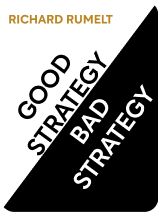

This article is an excerpt from the Shortform book guide to "Good Strategy Bad Strategy" by Richard Rumelt. Shortform has the world's best summaries and analyses of books you should be reading.
Like this article? Sign up for a free trial here .
How does one tell a bad strategy from a good one? What are the signs that your business is operating under a misguided strategy?
According to author and UCLA management professor Richard Rumelt, there are four elements that can signal a misguided strategy: 1) fluff, 2) failure to identify the challenge, 3) conflation of goals with strategy, and 4) misguided strategic objectives. The effects of bad strategy can be seen in everything from the failures of corporations to the poor performance of our educational system.
Keep reading to examine four elements that can create a misguided strategy.
The Four Elements of Bad Strategy
A bad strategy is not simply the absence of any strategy, nor is it a good strategy that has failed. Rather, it is a poorly thought-out strategy that’s based on misconceptions and misguided leadership.
There are four major elements of bad strategy:
1. Fluff
When a corporation uses fancy phrasing to describe their grand vision or performance goals, they often call it strategy. It’s not. It’s “fluff.”
At its core, “fluff” is the statement of an obvious fact sprinkled with industry buzzwords. Because of its lofty vocabulary and convoluted sentence structure, fluff is often mistaken for intelligent expertise, but only authentic analysis makes a complex issue understandable. Fluff works in the opposite direction, injecting complexity into simple concepts to cover up a lack of insight, original thought, or useful directives.
For example, a bank might say their core strategy is “customer-focused intermediation.” Here, “intermediation” merely means being the middleman between customer transactions, and “customer-focused” simply means working with customers. Replacing the buzzwords gives you a simplified statement: “Our bank’s strategy is to be a bank.” There’s nothing useful there that shows how this particular bank is going to set itself apart from the competition.
Fluff often shows up in the information technology industry; an EU report talked of “cloud computing” as “an elastic execution environment of resources involving multiple stakeholders and providing a metered service at multiple granularities for a specified level of quality-of-service.” Taking out the buzzwords, this translates to “a group of servers providing a range of services.” It’s a meaningless, vague, and general description; not an actionable strategy.
Case Study: Arthur Anderson
The fall of accounting firm Arthur Anderson shows the danger of using fluffy industry-speak to obscure a lack of solid foundations.
In 2000, Arthur Anderson was helping the energy-trading and utilities company Enron enter the bandwidth-trading markets. This was a fundamentally different market from Enron’s previous areas of expertise—the gas and electric markets, through which it had access to information on supplies and demand that gave it a competitive advantage over other traders.
In moving into bandwidth-trading, all of Enron’s expertise and competitive advantages disappeared. Bandwidth was not quantifiable nor deliverable in the same way gas and electricity were. Enron was not the central player in the market and so had less access to critical data. Further, the bandwidth market was fundamentally different than gas and electricity markets because capacity and demand followed different rules, which Enron’s lack of expertise in the market blinded them to.
Instead of acknowledging and addressing these challenges, Arthur Anderson flooded its own corporate communications with fluffy visuals and statements with industry words like “market enablers,” “over-the-counter broker,” and “electronic trading platform,” which were merely ostentatious ways of saying that they would help Enron function as a trader. Arthur Anderson enticed investors to sink their money into this unproven business, covering up their lack of knowledge with overblown vocabulary.
By the time Enron filed for bankruptcy protection in December 2001, it was clear that Arthur Anderson had not actually understood or devised a viable strategy for the bandwidth market, and had relied on industry-speak, given credence by their reputation, to mask their lack of knowledge.
2. Failure to Identify the Challenge
The second way strategies typically fail is that they don’t properly identify the core challenges an organization faces so that these challenges can be planned for. If a problem is not well defined, you can’t devise a workable solution to it. Further, you can’t distinguish a good strategy from a bad one if you don’t know what obstacle it aims to overcome, and you therefore will be more susceptible to choosing a bad one unwittingly.
Case Study: International Harvester
The fall of International Harvester (IH) is an example of what can happen when a company fails to identify the one core challenge that is more critical than all the others.
IH was once one of the largest corporations in the United States. However, by the late 1970s it was a sleepy outfit with declining profits. In 1979, in an attempt to turn the company around, it published a dense, lengthy new corporate strategy. The plan consisted of five separate plans, one from each of the company’s divisions—truck making, gas turbines, components, agricultural equipment, and industrial equipment.
The plan was detailed but failed to identify the primary challenge facing the company: an inefficient work structure. IH’s profit margins were close to one-half those of their competitors at the time because its organization encouraged ill-thought-out and frequent transfers of personnel. Further, the company had one of the worst labor relations in the industry, which increased costs.
Because its plans to invest in new equipment and cut administrative overhead did nothing to address its actual main challenge, the company was unable to halt its decline. Though profits improved for a couple of years after the implementation of the new strategy, a poorly-resolved labor dispute left IH hobbled and by 1985, it had lost over three billion dollars and been forced to lay off 85 percent of its workforce. It was finally broken up and with the exception of one trucking division, it was sold piecemeal.
Case Study: DARPA
In contrast to the failure of IH, the success of the Defense Advanced Research Projects Agency (DARPA) illustrates what can happen when an organization adopts a strategy that places its primary challenge front and center.
DARPA’s stated challenge is to find technological solutions for military problems. They note that this challenge has two sub-challenges: First, some problems have unclear solutions, and second, some solutions may not ultimately work, so there is risk inherent in developing them.
They focus their efforts and resources on projects the military avoids because they are too difficult and have uncertain returns on investment. Some of DARPA’s successes include ballistic missile defense, the first iteration of the Internet, stealth technology, GPS, and unmanned land and air vehicles.
DARPA’s strategy has been successful because it starts with a clear identification of their primary challenge and then concentrates its actions and resources on that challenge. It is focused; it doesn’t try to address all military problems but only the ones that fall into their space, and it doesn’t spread its resources thinly between internal interests. Likewise, the strategy is specific—it defines policies that drive its daily operations. It is devoid of fluff.
3. Conflation of Goals With Strategy
The third way strategies fail is that they don’t identify actual strategies, but instead name performance goals—five-year budgets paired with market share projections, for instance. For example, a company might outline a plan to increase revenues by twenty percent, become the industry leader, or increase customer retention by ten percent. These are goals, not actionable strategies.
A company might also decide that stronger motivation is their strategic game plan, as if a failure to want these goals is all that’s standing in the way of achieving them. It might then speak of a “culture of commitment” or “dedication to achievement,” which are great big-picture values, but are not strategies.
Strategy based on goals and motivation misses the insight that competition is about more than just strengths and wills; it is about judgment and aptitude. When you mistake goals for strategies and motivation for a plan, you can end up on a dead-end path hoping that if you just hang in there long enough, things will start to go your way. Organizations who mistake motivation for a strategy usually adopt a “never give up” attitude that compels them to commit to a losing position even when the data says they should adjust their aims or actions.
Case Study: Douglas Haig
A tragic example of this goal-based, motivation-driven strategy underpinned by a “hang in there, don’t ever give up, just keep trying harder” mentality was the slaughter of Allied troops during the First World War outside the Belgian village of Passchendaele.
In 1917, British general Douglas Haig decided to break through German lines in that region to open up a path to the sea. He envisioned that this would divide and weaken the German army. His advisors told him that shelling German fortifications would destroy the Belgian dikes and submerge the area in seawater. Ignoring their advice, he bombed the fortifications anyway and destroyed the dikes. The resultant flooding turned the entire area into a morass of sticky clay that swallowed men to their waists and drowned tanks, horses, and the wounded.
Though Haig had, prior to the battle, promised to call off the attack if it didn’t go their way, once his operation was underway he refused to back down, committed to the idea that “one last push” might turn the tide in his favor. After three months, more than 70,000 Allied soldiers had died in the attack and another 250,000 were wounded—and only five miles of ground had been gained.
In this tragedy, the Allied forces did not suffer from a lack of motivation or perseverance; they suffered from a lack of a strategic game plan that would either make their efforts worthwhile or cause them to redirect.
4. Misguided Objectives
A fourth way strategies can fail is by choosing misguided objectives. Objectives are different from goals. Goals are broad, big-picture visions. Objectives are subgoals: specific approaches that will allow an organization to accomplish those larger goals. Strategy is the road map linking objectives to goals.
For example, the United States’ goals may be freedom, peace, security, and justice. Its objectives may then be to defeat the Taliban and establish a working government in Afghanistan. These objectives will form its strategy.
Sometimes, leaders don’t choose their objectives wisely. There are two common mistakes leader make when defining objectives:
- Too many objectives: In choosing objectives, a leader must focus on just one or two key areas. Very often, leaders fail to narrow down their objectives. Consequently, they end up with an unfocused wish list of competing suggestions submitted by a wide range of department heads and shareholders, with no overriding vision on how to balance or prioritize them. Local governments and school districts tend to be especially guilty of this, but it’s not unheard of in corporations as well. Such strategic plans sometimes include hundreds of “strategies.”
- All ambition, no direction: A leader must also set objectives that connect the challenge to the solution in clear, realistic steps. Too often executives will publish objectives that aim to accomplish great things but with no details on how to get there. Or, their strategy statements simply restate the overall goal or challenge, without concrete guidance on what to do. If a leader’s objectives are just as vague or as difficult to accomplish as the overall goal, the strategic plan adds no value.
Case Study: Chen Brothers
The journey of the organic food distributors Chen Brothers illustrates the proper way to use strategic objectives to accomplish goals. The company outlined specific, focused objectives and shifted them as needed in response to short-term challenges in order to achieve long-term success.
Chen Brothers was a specialty food distributor that aimed to increase profit and become the leading distributor for organic products. The company didn’t fall into the trap of thinking these overall goals were a strategy; instead, it developed a very specific set of objectives to accomplish them. These objectives targeted local specialty retailers with well-thought-out sales and marketing methods.
With the rise of Whole Foods, though, the market changed. Chen Brothers adjusted accordingly. They didn’t adjust their goals—they still aimed to be market leaders in organic food distribution—but they adjusted their objectives, and thus their strategy. Instead of targeting a hodge-podge collection of local retailers, they set their sights exclusively on Whole Foods and developed a plan to unite local food producers under a common label that could be sold at the national chain.
In this way, the company successfully focused its energy and resources on one or two important short-term objectives that would position it to accomplish its long-term goals. Once those objectives were met, it was able to adopt new objectives, ones targeting, for example, shelf space and market share.
Case Study: Los Angeles Unified School District
In contrast, the difficulties of the Los Angeles Unified School District (LAUSD) illustrate what happens when a leader doesn’t choose objectives wisely.
In 2006, David Brewer took over LAUSD as superintendent with the directive to improve its educational performance. Brewer started off well by narrowing his focus to just the 34 lowest-performing schools in the district.
However, the objectives he chose to pursue in regards to those schools fell into the “all ambition, no direction” trap. He set goals such as creating “transformational leaders” but didn’t define what this meant or provide guidance on how to become such leaders. Likewise, he ignored the fact that teachers and administrators were stretched to capacity just keeping up with daily problems and had no decision-making power anyway within the highly regulated bureaucracy of the system. He also initiated a volunteer-parent-led community outreach program at each school, a hugely unrealistic ambition given that much of the underperformance of the students was due to poverty and the unstable family lives that often resulted from this.
The Three Causes of Bad Strategy
Now that we’ve defined bad strategy, let’s explore why there’s so much of it around, and why people don’t generally develop good strategy when tasked to.
There are three primary reasons behind bad strategy:
- The inability to choose between competing values and priorities
- The lure of strategy-by-template
- The false promise of positive thinking
These three points are discussed below.
1. The Inability to Choose Between Priorities
One of the main drivers of bad strategy is an inability to prioritize interests. Often, complex organizations like corporations or governments are too concerned with placating the various and diverse interests within their operations to develop a focused, targeted strategy that concentrates resources into one specialty. It can be unpleasant to make hard choices that favor one coalition over another, and therefore, large, successful organizations can end up with a hodgepodge of conflicting goals and interests among their various parts. When they try to accommodate all of these conflicting interests by spreading resources evenly around, they end up with unfocused, bad strategy. To create good strategy, leaders must be willing to say no to these varying interests.
Making choices is difficult because it means that some people and departments within the organization will be worse off, and therefore will resist such decisions. Making such choices gets even more difficult when a company is more established; the longer certain interests have been allowed to assert themselves, the more entitled they feel to their participation.
In the case study we looked at earlier of the U.S. Desert Storm operation, it’s worth noting that one of the main reasons Schwarzkopf’s strategy worked is that he ignored pressures from various parts of his organization who wanted to play bigger roles in the offensive. For example, sea-based Marines wanted to fight but he told them to simply station themselves off the coast as a decoy, the Air Force wanted to participate with strategic bombing but he forbade them to, and the Secretary of Defense (Dick Cheney) wanted to implement a different action plan but Schwarzkopf refused. Resisting the pull of these internal factions allowed him to maintain a focused, clear strategy.
2. The Lure of Strategy-by-Template
Another source of bad strategy is the lure of template-style fill-in-the-blank strategy that promises easy solutions without much thinking. This type of strategic planning grew out of the business world’s obsession with charismatic leaders.
In the mid-1980s, business thinkers noted that transformational leaders can have an outsized impact on a company’s future, and then mistakenly conflated strong, charismatic leadership with strategy. This gave rise to the false belief, held by many organizations, that if they had a strong leader, they had a good strategy.
In chasing this myth, management experts tried to boil leadership down to a formula with three elements. According to this theory, a good leader:
- Has a vision
- Empowers people to enact that vision
- Inspires people to value the organization over their own interests
While this may be a good way to develop strong leadership, it does not address strategy. Leadership may be about vision, but strategy is about figuring out the specifics of how to accomplish that vision.
The leadership template and its assumed connection to strategy gave rise to a related template designed to capture the essence of a company’s strategy in a fill-in-the-blank sort of way. You’ll often see it in a business plan or annual report. Unfortunately, these templates encourage vague statements of goals and ambitions, rather than clear analysis of challenges and solutions. You’ll typically see sections for the following prompts:
- Vision: Where do you see your company in the future? (Here, strategy writers often use words like “the best” or “most profitable.”)
- Mission: What is your purpose? (This often sounds lofty, mentioning “passion” and “innovation.”)
- Values: What are your company’s values? (These are typically non-controversial values; think “respect” and “integrity.”)
- Strategies: What are some goals and subgoals that you can call strategies? (You’ll see words like “portfolio” and “management.”)
The end result of this type of strategy formation, which is used enthusiastically by corporations, schools, and government agencies, is a list of buzzword-filled goals-as-strategies; statements of the obvious with no actual plan. For example, the mission statement of one well-known New York State private university is to be “a learning community that seeks to [educate] leaders of tomorrow.” In other words, it seeks to be a university, with no greater specificity than that.
Because these strategic development tools are so popular, they show up in many corporate plans, leaving a person who wants to develop a better strategy with limited models to emulate.
3. The False Promise of Positive Thinking
The obsession with charismatic leaders has contributed to bad strategy development in another way, too: the fascination with the idea of positive thinking.
Many organizational leaders develop “strategy” that is, at its core, nothing more than grandiose visions of success paired with motivational, can-do language. Often this is because popular cultural notions of fantastically visionary leaders have led people to believe that positive thinking is the most powerful tool a leader can wield. Belief in this myth blocks out more focused, critical thinking and sets up companies for failure. Centering your strategy around “wishful thinking” can only result in directionless plans with little useful guidance.
The “power of positive thinking” movement has its roots in American religious doctrines and transcendental writings from the 1800s, in which philosophers like Ralph Waldo Emerson as well as Protestant theologians proposed the idea that individuals have a “divine spark” inside of them that allows them to understand great visions. By the late 1800s, this line of thinking had evolved to argue that the power of thought can affect the physical world: thinking about success can bring about success, and thinking about failure can bring about failure. This was called the “New Thought” movement.
Since then—throughout the twentieth century and right up until today—motivational writers have encouraged people to apply these kinds of philosophies to their business plans, reasoning that through the “law of attraction,” they will draw good things to themselves and their companies simply by thinking about good things.
Unfortunately, in advancing such theories, management advisors extoll the visions of an organization’s leaders but ignore any other elements that go into the company’s success, as if the only important element of strategy is wanting success strongly enough. For example, Steve Jobs is often lauded for his visionary thinking, but ambition had less of an impact on Apple’s success than did competence and a specific competitive advantage: the technological development that allowed the Apple II to directly connect to the floppy disk rather than using expensive controllers.

———End of Preview———
Like what you just read? Read the rest of the world's best book summary and analysis of Richard Rumelt's "Good Strategy Bad Strategy" at Shortform .
Here's what you'll find in our full Good Strategy Bad Strategy summary :
- The essential components of good strategy and the faulty thinking behind bad strategy
- Specific and measurable techniques for designing a focused strategy for success
- How to overcome challenges and gain a competitive edge






